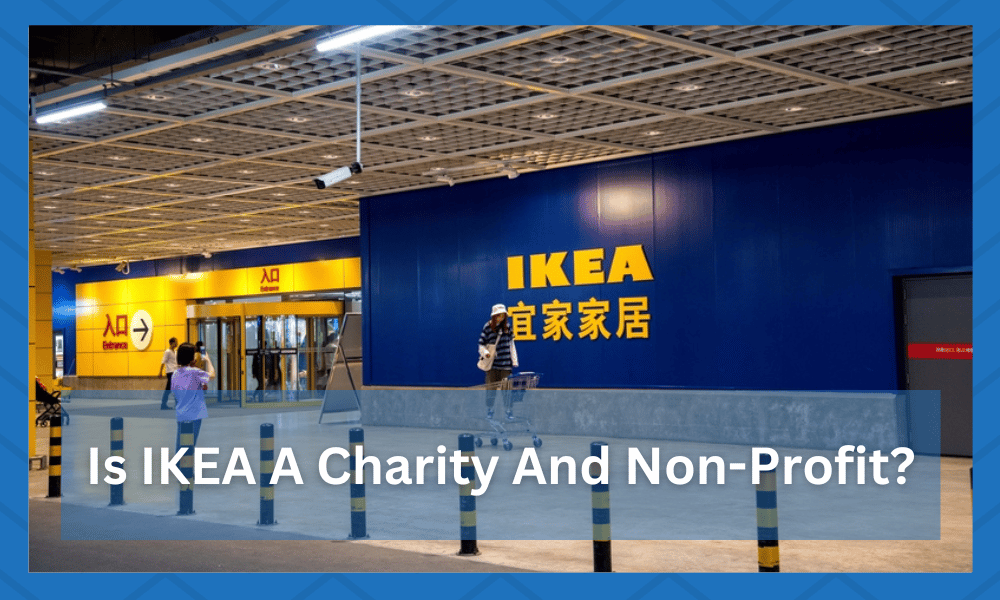
The Swedish furniture store IKEA is well-known among many. It has great deals on furniture and encourages a sense of community. What many don’t know, however, is that IKEA is a non-profit.
There are many reasons for IKEA’s non-profit status.
One of these is that Ingvar Kamprad’s owner was very charitable. In 2013, five years before Kamprad’s death, he claimed his wealth was 108 million euros. This seems like a huge chunk of money but is quite small for the IKEA owner.
His wealth was estimated at 43.2 billion euros. He claimed that in 1982, he gave all his profits to charity. He also transferred his IKEA ownership title to The Stichting Ingka Foundation in the same year.
This foundation is where all of IKEA’s profits go to.
In addition, the foundation works towards sustainability and social responsibility. It has invested in renewable energy sources, reducing waste, and supporting education for children worldwide.
Is IKEA a Charity or a Non-Profit?
The Stichting Ingka Foundation also supports women’s empowerment programs in developing countries.
IKEA may not have the name of a charity; however, its non-profit status allows them to give back to the community.
So the next time you shop at IKEA, know that your purchases also give back to those in need.
While being a very charitable man, Kamprad was also very frugal. He lived the life of a minimalist.
He scrimped for clothes, traveled in coach, ordered inexpensive food, and drove a 1993 Volvo. He also lived in a small home and shopped at his local market.
This may contribute to why he was so about affordability in his store. It also explains why he lived abroad in Switzerland for 40 years.
He did not agree with Sweden’s high tax rate and wanted to evade it. IKEA’s non-profit status helps Kamprad keep his minimalist lifestyle even after his death.
Does IKEA carry out an audit?
Yes, like any company, IKEA carries out an audit to ensure they are following all regulations and financial standards.
The Stichting Ingka Foundation also has guidelines and policies regarding its non-profit status. These audits are performed by external auditors as well as internal audit teams.
In addition to financial audits, IKEA also conducts social and environmental audits of its suppliers.
These audits assess the suppliers’ compliance with IKEA’s code of conduct, including labor rights, health and safety standards, and environmental impact. The results of these audits inform IKEA’s sustainability efforts and any necessary steps to improve supplier practices.
These audits help ensure that IKEA operates ethically and responsibly in all aspects of its business. By continuously monitoring and improving its practices, IKEA strives to live up to its goal of creating a better everyday life for people and the planet.
Does IKEA have an Inclusive policy?
Yes, IKEA is committed to diversity and inclusion in its operations. This includes having a diverse workforce and promoting equal opportunities for all employees.
IKEA also strives to be inclusive in its marketing efforts, showcasing a diverse range of people and families in its advertising materials.
The company offers products and services that can be enjoyed by people of all abilities and needs, such as wheelchair-accessible furniture and braille labels.
IKEA’s commitment to diversity and inclusion aligns with its overarching values of togetherness and simplicity for everyone. The company aims to create a welcoming and inclusive environment in all aspects of its business.
Does IKEA cut charity from the regular funds?
No, IKEA does not cut charity from its regular funds. The company strongly focuses on social responsibility and giving back to communities.
IKEA supports various global charities and initiatives, including UNICEF and Save the Children. The Ingka Foundation, owned by the Kamprad family who founded IKEA, has also donated significantly to various social and environmental causes.
In addition to charitable giving, IKEA supports communities through its business operations. This includes creating employment opportunities, offering training programs, and promoting sustainable practices in their supply chain.
IKEA prioritizes positively impacting society and the environment in all aspects of its business. Charity and community support are integral to IKEA’s operations, not separate from the company’s regular funds.
Does IKEA take care of its employees?
Yes, IKEA takes care of its employees by offering competitive wages and benefits, a safe work environment, training opportunities, and support for career development. The company also prioritizes diversity and inclusion in its hiring practices and workplace culture.
IKEA’s employee well-being extends beyond the workplace as well. The company promotes a healthy lifestyle by offering healthy food options at its cafeterias and encouraging physical activity.
IKEA recognizes the importance of taking care of its employees and strives to create a positive work environment where people can thrive. This aligns with the company’s values of togetherness and simplicity for everyone.
Is IKEA a non-profit organization?
Yes, IKEA is a non-profit organization. The company is owned by Stichting INGKA Foundation, which controls all the IKEA stores worldwide.
This foundation focuses on supporting social and cultural causes through their profits rather than giving them to shareholders or owners.
IKEA was founded in 1943 by Ingvar Kamprad, who believed in the principle of “democratic design,” making high-quality, functional home furnishings accessible to everyone.
This belief is also reflected in their non-profit structure, as they prioritize using profits for social good rather than personal gain.
What makes an organization Non-Profit?
A non-profit organization, must meet certain criteria set by the government. Firstly, a non-profit organization must have a charitable purpose that serves the community or the public in some way.
This can include advancing education, religion, science, literature, and other areas of benefit to society. Additionally, a non-profit organization must not be operating for the use or profit of any individuals.
This means that profits made by the organization must be re-invested in achieving its mission, and no one person can personally benefit from the organization’s financial success.
Non-profit organizations also have a distinct legal structure, known as a 501(c)(3) organization. This designation is granted by the IRS, allowing non-profits to be exempt from certain taxes and receive tax-deductible donations.
To obtain 501(c)(3) status, non-profits must file paperwork with the IRS proving their charitable purpose and demonstrating their compliance with legal guidelines.
It is important to note that non-profit organizations can still profit if it is not distributed among individual members and is used to further the organization’s mission.
Additionally, while some non-profits may rely solely on donations and grants, others also generate income through selling goods or services.
Non-profit organizations play an essential role in society by providing services and support that government and for-profit businesses may not adequately address.
These organizations often fill critical gaps in communities, such as homelessness outreach or promoting arts and culture.
However, they also face unique challenges, including limited funding and reliance on volunteerism. IKEA Foundation’s support of non-profit organizations is crucial in helping them continue their important work and positively impact society.
In addition to supporting various social initiatives, IKEA has also made strides in sustainability and environmentally friendly practices.
They have committed to using only renewable and recycled materials in their products by 2030 and have invested heavily in renewable energy for their stores and manufacturing processes.
IKEA’s non-profit structure allows them to prioritize social responsibility and environmental stewardship in its business practices.
Their commitment to democratic design and improving the lives of individuals and communities make them a unique and impactful player in the home furnishings industry.
A simpler reason for their non-profit status is that it reduces taxes. The company is owned by a holding company, INGKA holding, owned by the non-profit The Stichting Ingka Foundation.
Because of this, it qualifies as a non-profit. This means IKEA is charged a 3.5% tax rate instead of 18%.
This saves the company 4 billion euros in taxes every day. If their profit margin is as high as their charity margin, they stay a non-profit.
Because of this tax break, IKEA is immune to being taken over. The Kamprad family will always make money off of IKEA.
There is another company, Inter IKEA Systems B.V, that owns the concept of IKEA and its name.
About three percent of what IKEA makes goes to this company, which sends money to offshore holding companies. Essentially, this money returns to the Kamprad family or is re-invested in the store.
IKEA donates money to a new generation of designers, too. They donate money to the Lund University School of Industrial Design and have for the last 20 years.
The money covers scholarships, stipends, and various other costs at the University. A specific IKEA foundation was created to manage these costs. It is called The Ingvar Kamprad Design Foundation.
Even though IKEA’s main reason for being a non-profit is to reduce taxes, they invest the money in the company to make it better for customers. They focus on providing livable wages for their employees, making affordable products, and creating a sustainable and good company for the environment.




